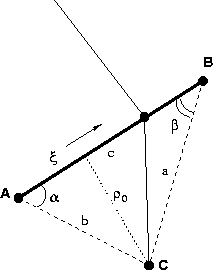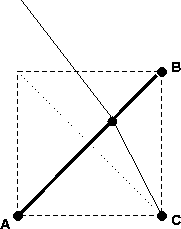




Next: Solving the eikonal equation
Up: Fomel: Fast marching
Previous: The theoretic grounds of
In this section, I derive a discrete traveltime computation procedure,
based solely on Fermat's principle, and show that on a Cartesian
rectangular grid it is precisely equivalent to the update formula
(1) of the first-order eikonal solver.
triangle
Figure 3 A geometrical scheme for the
traveltime updating procedure in two dimensions.
|
|  |

For simplicity, let us focus on the two-dimensional case![[*]](http://sepwww.stanford.edu/latex2html/foot_motif.gif) . Consider a line segment with the end points A and B,
as shown in Figure 3. Let tA and tB denote the
traveltimes from a fixed distant source to points A and B,
respectively. Define a parameter
. Consider a line segment with the end points A and B,
as shown in Figure 3. Let tA and tB denote the
traveltimes from a fixed distant source to points A and B,
respectively. Define a parameter  such that
such that  at A,
at A,
 at B, and
at B, and  changes continuously on the line segment
between A and B. Then for each point of the segment, we can
approximate the traveltime by the linear interpolation formula
changes continuously on the line segment
between A and B. Then for each point of the segment, we can
approximate the traveltime by the linear interpolation formula
|  |
(9) |
Now let us consider an arbitrary point C in the vicinity of AB. If
we know that the ray from the source to C passes through some point
 of the segment AB, then the total traveltime at C is
approximately
of the segment AB, then the total traveltime at C is
approximately
|  |
(10) |
where sC is the local slowness,  corresponds to the
projection of C to the line AB (normalized by the length |AB|),
and
corresponds to the
projection of C to the line AB (normalized by the length |AB|),
and  is the length of the normal from C to
is the length of the normal from C to  .
.
Fermat's principle states that the actual ray to C corresponds to a
local minimum of the traveltime with respect to raypath perturbations.
According to our parameterization, it is sufficient to find a local
extreme of tC with respect to the parameter  . Equating the
. Equating the
 derivative to zero, we arrive at the equation
derivative to zero, we arrive at the equation
|  |
(11) |
which has (as a quadratic equation) the explicit solution for  :
:
|  |
(12) |
Finally, substituting the value of  from (12) into
equation (10) and selecting the appropriate branch of the
square root, we obtain the formula
from (12) into
equation (10) and selecting the appropriate branch of the
square root, we obtain the formula
|  |
|
| (13) |
where c = |AB|, a = |BC|, b = |AC|, angle  corresponds to
corresponds to  , and angle
, and angle  corresponds to
corresponds to
 in the triangle ABC (Figure 3).
in the triangle ABC (Figure 3).
square
Figure 4 A geometrical scheme for
traveltime updating on a rectangular grid.
|
|  |

To see the connection of formula (13) with the eikonal
difference equation (1), we need to consider the case
of a rectangular computation cell with the edge AB being a diagonal
segment, as illustrated in Figure 4. In this case,
 ,
,  ,
,  , and formula (13) reduces to
, and formula (13) reduces to
|  |
(14) |
We can notice that (14) is precisely equivalent to the
solution of the quadratic equation (13), which in our
new notation takes the form
|  |
(15) |
What have we accomplished by this analysis? First, we have derived a
local traveltime computation formula for an arbitrary grid. The
derivation is based solely on Fermat's principle and a local linear
interpolation, which provides the first-order accuracy. Combined with
the fast marching evaluation order, which is also based on Fermat's
principle, this procedure defines a complete algorithm of
first-arrival traveltime calculation. On a rectangular grid, this
algorithm is exactly equivalent to the fast marching method of
Sethian (1996a) and Sethian and Popovici (1997). Second, the derivation
provides a general principle, which can be applied to derive analogous
algorithms for other eikonal-type (Hamilton-Jacobi) equations and
their corresponding variational principles.





Next: Solving the eikonal equation
Up: Fomel: Fast marching
Previous: The theoretic grounds of
Stanford Exploration Project
9/12/2000


![[*]](http://sepwww.stanford.edu/latex2html/foot_motif.gif) . Consider a line segment with the end points A and B,
as shown in Figure 3. Let tA and tB denote the
traveltimes from a fixed distant source to points A and B,
respectively. Define a parameter
. Consider a line segment with the end points A and B,
as shown in Figure 3. Let tA and tB denote the
traveltimes from a fixed distant source to points A and B,
respectively. Define a parameter ![]() such that
such that ![]() at A,
at A,
![]() at B, and
at B, and ![]() changes continuously on the line segment
between A and B. Then for each point of the segment, we can
approximate the traveltime by the linear interpolation formula
changes continuously on the line segment
between A and B. Then for each point of the segment, we can
approximate the traveltime by the linear interpolation formula
![]() . Equating the
. Equating the
![]() derivative to zero, we arrive at the equation
derivative to zero, we arrive at the equation



![]() ,
, ![]() ,
, ![]() , and formula (13) reduces to
, and formula (13) reduces to
